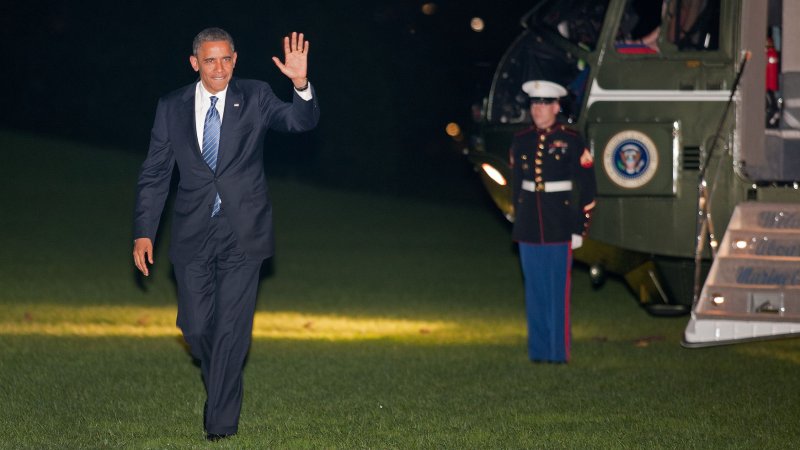President Barack Obama returns to the South Lawn of the White House following a day-trip to Miami, FL where he attended campaign events, in Washington, Thursday, Oct. 11, 2012. When asked by a reporter how he thought the vice president did in his debate this evening, the president responded, "I thought Joe Biden did great; I couldn't be prouder". UPI/Martin H. Simon |
License Photo
ARLINGTON, Va., Oct. 15 (UPI) -- The U.S. economy will likely grow 3 percent in 2013's fourth quarter and unemployment will return to 7.8 percent after inching up, a survey indicated Monday.
The gross domestic product growth rate is expected to cap a year of steadily accelerating economic expansion, with the average 2013 growth rate being 2.4 percent, the National Association for Business Economics survey of 44 professional forecasters indicated.
The current year's growth is forecast to be an average 1.9 percent, the panelists said.
The last time the U.S. economy grew at 3 percent was at the end of 2011.
It grew just 1.3 percent in the second quarter this year, the U.S. Commerce Department said Sept. 27 in its third estimate of that April-to-June period. It grew at a 2 percent pace in this year's first quarter.
The department is to release its first estimate of third-quarter growth Oct. 26.
The NABE panel said it expected employers would add an average 155,000 jobs a month next year, up from this year's average 132,000 a month.
Employers added a modest 114,000 jobs last month, the Labor Department said Oct. 5.
The unemployment rate will likely be 7.8 percent by next year's fourth quarter, its rate last month, after returning to 8.1 percent in the current quarter, the panelists said.
Until September, the unemployment rate was stuck between 8.1 percent and 8.3 percent all year.
"The quarterly forecast figures suggest a pattern of slow but steady increase in employment," the NABE Outlook said.
Inflation is expected to remain low, with so-called core inflation expected to be 1.9 percent next year, the panelists said.
Core inflation excludes volatile and seasonal food and energy prices.
Broader inflation measures -- such as the consumer price index, which approximates a cost-of-living index -- are expected to show a 2.2 percent inflation rate, due largely to rising commodity prices, the survey indicated.
Crude oil is expected to advance 3.8 percent as growth picks up, the panelists said.
Other indicators the panelists weighed in on:
-- Consumer spending is expected to grow 2 percent next year after being 1.9 percent this year.
-- Housing starts are expected to increase 13 percent, up from 23 percent growth this year.
-- The Standard & Poor's 500 stock market index of the common-stock prices of 500 top publicly traded U.S. companies is expected to reach 1,520 at year-end next year after closing at a forecast 1,450 this year. It closed Friday at 1,428.59 and ended 2011 at 1,258.
The NABE survey respondents said they generally didn't expect the worst to come from the looming "fiscal cliff" of painful tax rises and spending cuts that will automatically begin Jan. 2 unless the newly elected president and Congress can quickly agree on a compromise.
Those billions of dollars of tax increases and federal spending cuts would reduce the federal deficit but threaten to plunge the nation back into a recession.
The tax cuts that would end were worked out between President Barack Obama and congressional Republicans to help the economy after the 2010 elections. The automatic spending cuts were part of a deal worked out between Obama and the lawmakers to end last year's debt-ceiling crisis.
Fifty-five percent of NABE respondents said they thought the George W. Bush-era tax cuts would remain for another year for all income levels, while 36 percent said they thought the cuts would be extended for lower-income tax brackets but not for high-income earners.
Fifty-nine percent said they expected the 2 percentage-point cut to the payroll tax that funds Social Security and Medicare to expire Jan. 1 as scheduled, while 34 percent predicted it would be extended another year.
Seventy-seven percent said they believed Congress' alternative minimum tax "patch" -- which shields millions of taxpayers from paying the onerous AMT by increasing the amount of exempt income -- would remain in place for this tax year.
The NABE survey of applied economists, strategists, academics and policymakers was conducted Sept. 14-26.










